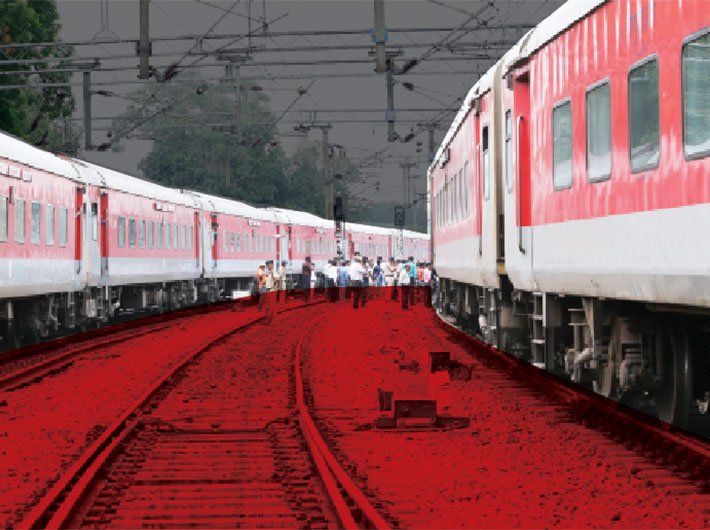Finally, seven decades after independence, efforts are on to increase the speed of some trains. There are hurdles in the journey ahead, though
The Indian Railways’ Mission Raftaar, a project to increase the speed of trains on busy routes to reduce travel time, is finally picking up pace. Keeping in mind the 2019 Lok Sabha elections, railways minister Piyush Goyal has asked officials in his ministry to fast-track several rail projects, including Mission Raftar, to woo the passengers.
Introduced in the rail budget 2016-17, Mission Raftaar aims to offer semi-high-speed trains to passengers by running trains at a speed of 160-200 kmph in select corridors of the country. The project has been approved recently by the Niti Aayog and the extended board of the railways. However, it is still awaiting a clearance from the cabinet. In April 2016, the ministry had set up a mobility directorate to initiate measures for increasing the speed of trains.
The railways has chosen nine corridors where trains are proposed to run between 160 kmph and 200 kmph. They are: Delhi-Agra, Delhi-Chandigarh, Delhi-Kanpur, Nagpur-Bilaspur, Chennai-Bengaluru-Mysore, Mumbai-Goa, Mumbai-Ahmedabad, Chennai-Hyderabad and Nagpur-Secunderabad. These are the principal routes of the Indian Railways as they carry 58 percent of freight and 52 percent of passenger traffic with a share of only 15 percent of the total rail network.
At present, the average speed of goods trains is 25-27 kmph. The average speed of mail and superfast trains is around 55 kmph, while the average speed of premium trains like the Rajdhanis and the Shatabdis is 80-85 kmph.
To realise the dream of Mission Raftaar, the Indian Railways need to double the average speed of freight trains and increase the average speed of superfast express trains by 25 kmph in the next five years, which is not an easy task.
Many former railway board officials also believe that it would be an uphill task for the railways. The major challenges, according to them, would be to re-strengthen the old railway bridges, introduce an ultra-modern and expensive signalling system and fencing identified corridors.
Sunil Kumar, former additional member, railway board (IT) and advisor safety, says, “There are three things required for a semi-high-speed network: defect-less tracks, signalling and rolling stocks.”
A former chairman of the railway board (CRB), on condition of anonymity, told Governance Now that the German LHB coaches and locomotives, which the railways possess, are fit for 160 kmph operations. “The only problem is the old bridges, which are 100 years old. Trespassing is a major cause of concern. If trains run at a speed of 160-200 kmph, there should be no trespassing and the route should be fully fenced,” he says. Trespassing can be prevented by constructing road over -ridges, road under-bridges and underpasses, which is going to be an expensive affair.
A railway official agrees but says for trains to run at 160 kmph a modern signalling system, train protection and warning system (TPWS), as used in the Gatimaan Express, is also needed.
Moreover, the curvature of tracks is another problem to run the trains at such high speeds, feels SK Vij, former member (engineering), railway board.
“For running trains at 160 kmph, the ultrasonic flaw detection mechanism has to be very good. Huge investment will be required to have a modern signalling system, defect-free tracks and training of manpower,” says Sunil Kumar.
The construction of fencing is also not going to be cheap. It requires Rs 80 lakh per kilometre or Rs 400 crore for 500 km to build the fence along the chosen tracks.
But a senior official from the mobility directorate says that the expenditure for semi-high-speed train project would be less than the high speed network and metro system. “It would require around Rs200 crore per km for the high speed rail network and for the metro, it is Rs 150 crore. Compare Mission Raftaar with the other ambitious projects like the high-speed rail, it requires only Rs 8-9 crore per km,” he says.
For implementing such a big project thorough, planning is needed. The speed of trains cannot be increased in one go. China started upgrading its rail network in a phased manner since 1992. Because of its meticulous planning the country now has a high-speed rail network of over 20,000 km. “In India, one project is announced after another; and the railways is not able to prioritise the projects on which it should work first,” says the former CRB.
“The average speed of Chinese railways used to be lesser than the Indian Railways around two-three decades back but they gradually increased the speeds from 100 kmph to 160 kmph. Then to 200-250 kmph and finally built the high-speed rail network at 300-350 kmph,” he adds.
Furthermore, there is mix traffic in India, which means passenger and freight trains run on the same tracks. “It is now that the government is focusing on upgrading the speed of a select few trains. Many important trains are not able to run on their maximum speed because of the freight movement on the same track. The dedicated freight corridor, which is being built, would reduce the load on the tracks and facilitate faster movement of express trains,” says the former CRB.
Technical expertise for Mission Raftaar is also a big hindrance for the Indian Railways. “We have the rolling stocks which can run at 160 kmph but when it comes to operating the trains at 200 kmph we do not have the desired technical expertise. The Indian Railways has foreign collaborations for the 200 kmph project. But it would be possible only when we get the report from the concerned teams,” says the official from the mobility directorate. As of now the mandate is to increase the speed to 160 kmph provided the maximum travel shall not exceed to more than 12 hours.
SK Vij, on the other hand, believes that the railways should first try to increase the average speed of passenger and freight trains before contemplating to operate trains at 160 kmph. “We should not pursue higher maximum speeds on the existing network. Raising average speeds of both goods and coaching trains will generate capacity and revenues,” he says.
While Kumar feels that if the railways work meticulously it will be able to run the trains at 160 kmph within three years. “Keeping the existing traffic in mind, the railways should be able to make at least 200-300 km of tracks fit for 160-kmph operations every year,” he says.
Currently, the railways’ main focus is on two major routes – Delhi-Mumbai (1,400 km) and Delhi-Howrah (1,447 kms) – where trains would run at 160 kmph. At present, the Delhi-Mumbai Rajdhani runs at an average speed of 88 kmph and Delhi-Howrah Rajdhani at 86 kmphp.
The sanctioned project cost of Delhi-Mumbai corridor is Rs 11,189 crore and for Delhi-Howrah it is Rs 7,000 crore. The centre will bear the entire expenditure for these routes. The mobility directorate official says that the work would start immediately once the cabinet gives its go ahead.
Another route where the feasibility study is being carried out is Chennai-Bengaluru-Mysore. Here, the Chinese are conducting the study, which is fully funded by them. On this route, trains would run at 160 kmph. Since, it is a hilly terrain and has sharp curves, trains cannot run at 200 kmph here.
France’s state-owned railway company, SNCF, is carrying out the feasibility study of the Delhi-Chandigarh (243 km) route where trains are proposed to run at 200 kmph. SNCF is submitting its report to the Indian Railways on November 27, and it would be examined by the railway board and the research designs and standards organisation (RDSO). SNFC bagged the Rs 19.6 crore contract for the feasibility study in December 2015 on an equal cost sharing basis between the two countries.
The feasibility study for the Nagpur-Secunderabad (581 kms) route, where trains are proposed to run at 200 kmph, was started in June this year. It is expected to be completed by June 2019. The cost of the study is Rs 59 crore and would be equally shared by India and Russia.
Similarly, a joint declaration has been signed with Germany to prepare the feasibility report for the Chennai-Kazipet route to run trains at 200 kmph. The study is yet to start.
A railway official says that except for the Mumbai-Goa and Nagpur-Bilaspur corridors, all the other proposed routes have been touched upon for speed upgradation.
vishwas@governancenow.com
(The article apperas in December 15, 2017 issue)

